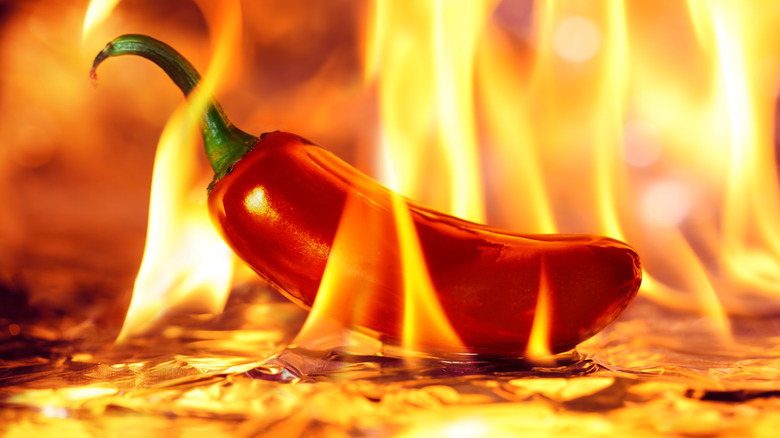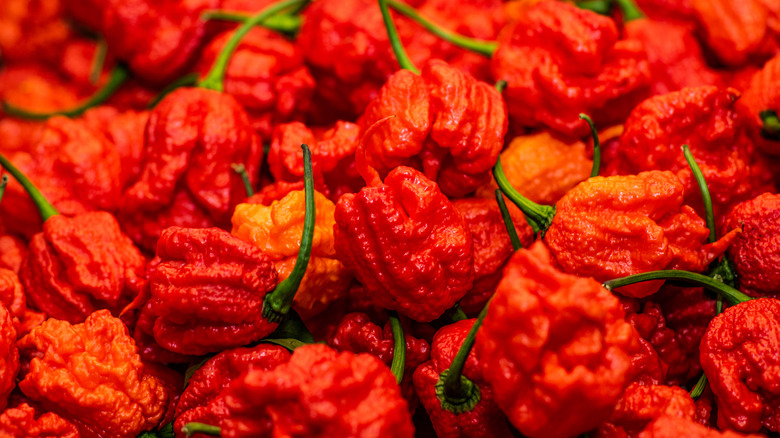The Peppers That Make Buffalo Wild Wings' Blazin' Sauce So Spicy
We may receive a commission on purchases made from links.
Since its founding in 1982, the casual dining franchise Buffalo Wild Wings has continued to thrive in the restaurant business, and it shows: The chain was ranked as the No. 1 sports bar/pub franchise of 2022, per Franchise Chatter, at the time of this writing. After the devastating effects of the COVID-19 pandemic, Buffalo Wild Wings bounced back in 2021 with $3.718 billion in sales, which was a 17% increase from the year before, according to the Nation's Restaurant News. However, even with all of Buffalo Wild Wings' success, perhaps the hottest thing about the franchise is still its Blazin' sauce (figuratively speaking, that is).
In a 2008 episode of the Food Network show "Unwrapped," Buffalo Wild Wings' Senior Director of Culinary Development Dudley McMahon praised the popularity of the franchise's tasty wings sauces. "We go through an amazing 52 million pounds of wings a year ... a million pounds a week," McMahon informed the television show's host Marc Summers at the time. Per the "Unwrapped" ep, BWW's most sought-after sauces were Honey BBQ and Spicy Garlic — but when it comes to literal heat, it's the restaurant's Blazin' sauce that blows all the other BBW signature sauces away on the Scoville scale. The reason? There's one peppery ingredient that makes Buffalo Wild Wings' Blazin' sauce so incredibly spicy.
Understanding Scoville units
Before diving into the history of the Buffalo Wild Wings' Blazin' sauce, foodies should be familiar with the Scoville scale. MasterClass notes that a Scoville Heat Unit (SHU) measures how hot a particular type of pepper is. For example, a bell pepper doesn't have any heat at 0 SHU, while jalapeño chili peppers clock in at approximately 10,000 SHU (which, to wit, is still on the milder side of the scale).
Pepper enthusiasts who want to feel a snackable burn can always turn to medium heat-level offerings like cayenne peppers (30,000 to 50,000 SHU) or Thai chilis (up to 100,000 SHU). Those who might feel ready for the next level can opt for habaneros, which can boast 350,000 SHU. (Yes, that is a hot pepper — and it's 35 times more intense than its much friendlier, kinder-on-your-tongue jalapeños.) Then there's the kind of burn requiring ice cream or milk remedies: ghost, scorpion, and Carolina Reaper peppers. These so-called super hots can leave your tongue, mouth, throat, and stomach ablaze at over 1 million SHU. Now that we're familiar with the Scoville scale, let's explore the history of the BWW Blazin' sauce over the years.
Blazin' 101: Habaneros, ghost peppers and Carolina Reapers
According to "Unwrapped," the original Buffalo Wild Wings' Blazin' sauce was conceived in the 1990s and it started off relatively low on the Scoville scale — at least compared to where the upgraded BWW condiment ranks today. But don't let that fool you — the original Blazin' sauce packed a punch thanks to the inclusion of habanero peppers in its secret recipe, which also included a jalapeño puree, chili peppers, lemon juice, and garlic.
Buffalo Wild Wings' Blazin' sauce has evolved over the years since habaneros served as the signature condiment's main ingredient. Ghost peppers, also known as the bhut jolokia, were the next fiery step in the Blazin' sauce's evolution, and those unforgiving Capsicum-filled chilis upped the Scoville ante from the habaneros' 350,000 SHU to over 1 million Scoville units, per MasterClass. These days, the latest incarnation of BBW's Blazin' sauce includes the hottest of all chilis in its ingredients: the dreaded Carolina Reaper peppers. Weighing in at a staggering 2.2 million SHU, the Carolina Reaper is over twice the Scoville units of ghost peppers. It definitely gives the term "sweat-inducing" a whole new meaning when it comes to Buffalo Wild Wings' famous Blazin' Challenge, in which participants must eat 10 of these hot-sauced wings in under 5 minutes, and must sign a liability waiver to do so.


